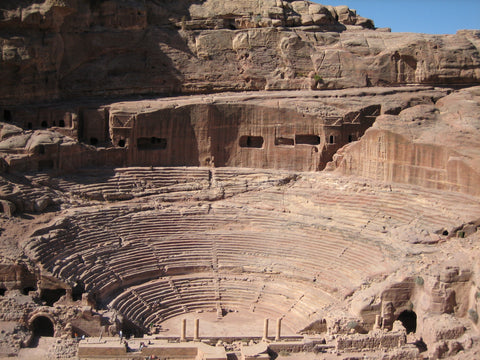Petra 🇯🇴

Petra (which means Rock in ancient Greek), is one of the most impressive cities of the ancient world. Popularized in 1989 by the film Indiana Jones and the Last Crusade, and known for its monumental tombs engraved into the rock, it is an archaeological site that fascinates. And that’s the topic we’re going to explore today!
So what is the story of Petra , this city forgotten for several centuries?
So what is the story of Petra , this city forgotten for several centuries?

Known today as one of the new seven wonders of the world , Petra was once a great trading city located at an important commercial crossroads of antiquity, in the south of what is now Jordan .
It was founded towards the end of the 8th century BC. BC by the Edomites (a small kingdom in the ancient Near East), but was inhabited by different peoples throughout its history.
People such as the Nabataeans —the famous builders of the monumental tombs of Petra —who began to inhabit this site around the 6th century BC. JC.
The Nabataeans are a nomadic trading Arab people from ancient times who gradually became settled in Petra .
The Nabataean Kingdom—whose capital was none other than Petra —flourished from 400 to 106 BC. JC. Indeed, at their peak, the Nabataeans controlled a vast territory encompassing Jordan, southern Syria and the northwestern part of present-day Saudi Arabia, and were among the richest Arab tribes.
Petra is thus endowed with a rich history, of which we do not know a great deal, but of which many vestiges have remained.
It was founded towards the end of the 8th century BC. BC by the Edomites (a small kingdom in the ancient Near East), but was inhabited by different peoples throughout its history.
People such as the Nabataeans —the famous builders of the monumental tombs of Petra —who began to inhabit this site around the 6th century BC. JC.
The Nabataeans are a nomadic trading Arab people from ancient times who gradually became settled in Petra .
The Nabataean Kingdom—whose capital was none other than Petra —flourished from 400 to 106 BC. JC. Indeed, at their peak, the Nabataeans controlled a vast territory encompassing Jordan, southern Syria and the northwestern part of present-day Saudi Arabia, and were among the richest Arab tribes.
Petra is thus endowed with a rich history, of which we do not know a great deal, but of which many vestiges have remained.

The best known of these remains are the famous tombs carved out of the rock by the Nabataeans and mixing Hellenistic architectural styles with theirs. Most of the tombs and temples having been built during the reign of the Nabataean king Aretas IV , from around 9 BC. BC to AD 40 JC, according to archaeologists.
The best known of these tombs being the Khazneh (from the Arabic الخزنة Khazne al-Firaun, “treasure of the Pharaoh”), which you can see below.
The best known of these tombs being the Khazneh (from the Arabic الخزنة Khazne al-Firaun, “treasure of the Pharaoh”), which you can see below.

But many other monuments and remains exist such as a theater, temples, and impressive canals, tunnels, diversion dams and even reservoirs which made it possible to control and conserve rainwater.


Then in 106 AD. JC, Petra was annexed by the Roman Empire . Moment from which it will gradually begin to lose its commercial importance following various earthquakes and the development of new maritime trade routes.
A commercial monopoly on the region, as well as a culture which would eventually dissolve under the Roman province of Arabia, and the Eastern Roman Empire which would succeed, until the city was forgotten around 700 CE .
A magical city, of incredible richness, and you should know that only 15% of the city has been excavated!
A commercial monopoly on the region, as well as a culture which would eventually dissolve under the Roman province of Arabia, and the Eastern Roman Empire which would succeed, until the city was forgotten around 700 CE .
A magical city, of incredible richness, and you should know that only 15% of the city has been excavated!
